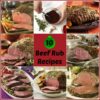How to Make Authentic Beef Tamales

The holidays bring countless traditions that hold a special place in the heart. As soon as Thanksgiving is over, everyone starts shopping and planning their Christmas festivities.
But here in Texas, one tradition reigns across many cultures, backgrounds and family dynamics: tamales.
Whether you make them, sell them, enjoy them (or a combination of all three), tamales are an integral part of the holiday season. Their rich history dates back to Aztec and Mayan civilizations, and have become a staple for many Texan families in today’s culture. They’re sold by restaurants, tamale factories and families. Tamales are made at home around Thanksgiving and the beginning of December, to be enjoyed on Christmas or New Year’s.
One of the most interesting things about tamales is the way they’re made at home by families. “Tamalada” refers to a gathering where tamales are made and served. Laughter fills the room, gossip is had and memories are made around bowls filled with masa, meat and corn husks.
Ellen Riojas Clark, Ph.D., former UTSA professor and co-author of “Tamales, Comadres and the Meaning of Civilization,” has been making tamales for over 57 years. She invited us to her home in San Antonio for one of her famous tamaladas. Watch her story here.
Our staff of Beef Loving Texans of course enjoys eating tamales, and became inspired with the idea of having our very own tamalada. We’re excited to share our experience as first-time tamale makers, in hopes that you’ll try it out in your kitchen this year!
To follow along with our Authentic Beef Tamale Recipe, click here.
Step 1: Go Shopping
If you’re a novice tamale maker like us, you’ll probably find yourself intimidated by the ingredient list for tamales. . . but you shouldn’t be. Other than pre-made masa, everything you need can be found at Fiesta Mart or most other local grocery stores.
We bought masa from a tortilla factory to save a little time, but masa harina is a common ingredient found in the baking aisle next to the flour. If you buy pre-made masa, and don’t plan on making tamales until the next day or so, it’ll need to be refrigerated.
Step 2: Soak the Corn Husks

No matter where this step falls in the recipe, do it first! The corn husks need to be soft enough for the masa to stick and spread easily. This takes several hours, so we did it overnight. That way you don’t have to worry about it while you’re completing the other steps.
Step 3: Cook the Beef

Brisket is the best cut of beef to use in tamales. When slow-cooked, it falls apart and melts in your mouth. . . which is already the beauty of tamales, right?
Cut the brisket into chunks (preferably large). Throw in onions, spices and cover with water. Bring to a boil, then simmer until tender. Set the beef aside to cool off in broth. Head’s up: this will take longer than you think.
Once it’s cooled, strain (reserving the broth) and chop roughly against the grain.

Step 4: Make the Masa

It was best that we made the masa while the beef was cooking, because this step took a while to get right.
Our pre-made masa was bought the day before, so it was cold and a little hard. We cut it into smaller pieces for easier mixing.
You’ll melt the lard and mix it into the masa one cup at a time, along with salt, baking soda and broth from the beef. Tamale experts might mix with their hands, but we used a Kitchen Aid mixer since it needs to be mixed for 10 minutes or more.
The masa needs to be fluffy, and the official way to test the consistency is the legendary “float test”. If a 1/2 teaspoon of masa floats in a cup of cold water, you know the tamales will be tender and light. If the masa doesn’t float, add more lard and keep mixing. It definitely took us a few tries!

Success!
Step 5: Make Chile Paste

Dried ancho chiles are an important part of most tamale recipes. They give the meat filling that signature tamale flavor! You’ll boil the chiles with comino seeds, then let them stand until they’re cool enough to slit open and de-vein. When soft, these chiles are very mushy, so do the best you can on this part.
After that you’ll grind them into a paste with a blender or food processor.
Step 6: Make Beef Filling

Melt lard, add chile paste and sautée for 3 minutes. Add beef, then some of the broth. Let cook for 10 minutes, until most of the liquid cooks down (the filling shouldn’t be watery).
Now you’re ready to make some tamales!
Step 7: Put Tamales Together

Now the funnest part is here. All the hard work of cooking is about to pay off as you sit around the table with your closest friends and family.
Cover your table with a tablecloth or paper, and set out the bowls of masa and beef. Dry off the corn shucks on towels. If you have enough people at your tamalada, you might want to separate the ingredients so everyone can reach what they need. Trust us, you’ll need all the hands you can get!
Use a spoon to spread a thin coating of masa over the widest end of the shuck. Spread the masa approximately 3 inches wide and 3 1/2 inches long. (The amount of masa comes down to preference, though).
Spoon beef filling down the middle of the masa. Fold the sides of the shuck together firmly and fold up the empty section of the shuck. This should form a tightly closed “bottom” and leaving the top open.

Step 8: Cook the Tamales
This is the last and FINAL step of the process. Give yourself a pat on the back!
Fill the bottom of a large soup pot (or tamale steamer) with water. Just enough to cover the bottom of the tamales once they’re put in – about an inch or so.

Now you need to put either a bowl or a medium-sized ball of aluminum foil at the bottom of the pot. Stack the tamales upright around whatever you put at the bottom, with the folded part facing down. Pack firmly but not tightly. Cover the tamales with corn husks and cover pot with a tightly fitting lid.

Cook tamales for about 1 1/2 to 2 1/2 hours over a medium flame. To make sure they’re done, remove one from the center and one from the side of the pot. They’re ready to eat when you open the husk and the masa peels away easily.

When our tamales were done, we separated them into batches of 12 and wrapped them in foil. Those who didn’t plan on eating their tamales right away put them in freezer bags to store away until Christmas.




